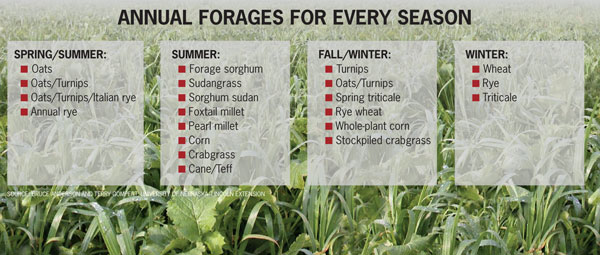Extend Your Forages

It takes good planning to have enough forage for your cattle year-round. When the weather doesn't cooperate, may it be drought, flood or snowdrifts, it pays to have a good plan in place with forage alternatives for the tough times.
One of the best ways to provide forage during the grazing season and beyond is by using annuals for grazing, haying and stockpiling. A variety of plants are available to help you extend your forage base during shortages.
"The first consideration is to decide when you'll need the annuals. It can be tricky timing an annual forage to supply it when it's needed," says Bruce Anderson, Extension forage specialist at the University of Nebraska–Lincoln.
Some productive annual forages for summer pasture include millet, sudangrass, sorghum-sudan hybrids, cane and teff. These warm season annual grasses can be planted in late spring or early summer, are drought-tolerant and have high yields and regrowth potential. Also consider corn as a summer annual forage.
"If pastures dry up, use corn by grazing small sections at a time. Or plant corn into wheat or oats stubble for a good pasture alternative," Anderson says.
For fall grazing, oats and turnips, planted separately or together, is another forage option. The crops can be grown from Mexico to Canada when moisture conditions are right for the shallowly planted turnip seeds.
"Turnips are a good choice if you have the land area to plant on a timely basis. For producers who have a cropping operation that uses cereal grains such as oats or wheat, turnips fit extremely well when planted into stubble," Anderson says.
Turnips are a nutritious alternative for cattle. The high-yielding plants provide not only a leafy top, but also a tasty bulb for grazing animals. Turnips contain 12% to 15% protein and up to 70% total daily nutrients.
In moderate climates, other small grains such as winter wheat, triticale and rye offer limited fall grazing with a growth spurt in late winter and early spring. Producers can also stockpile windrows of annual crops such as foxtail millet or sudangrass for grazing.
"Windrow grazing is best suited for grass crops because legumes will have more leaf shatter. Finer-stemmed grasses will work better because the windrows dry down faster without risk of molding," Anderson explains. "However, it is possible to use a crop such as sudangrass if the first cutting is used for hay and the regrowth is windrowed for later grazing." BT Scroll down for "Annual Forages For Every Season" chart.







